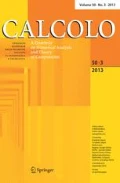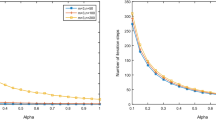Abstract
We are interested in finding a solution to the tensor complementarity problem with a strong M-tensor, which we call the M-tensor complementarity problem. We propose a lower dimensional linear equation approach to solve that problem. At each iteration, only a lower dimensional system of linear equation needs to be solved. The coefficient matrices of the lower dimensional linear systems are independent of the iteration after finitely many iterations. We show that starting from zero or some nonnegative point, the method generates a sequence of iterates that converges to a solution of the problem monotonically. We then make an improvement to the method and establish its monotone convergence. At last, we do numerical experiments to test the proposed methods. The results positively support the proposed methods.
Similar content being viewed by others
References
Berman, A., Plemmons, R.J.: Nonnegative Matrices in the Mathematical Sciences, Classics Edition. SIAM, Philadelphia (1994)
Bader, B.W., Kolda, T.G., et al.: MATLAB Tensor Toolbox Version 2.6 (2015). http://www.sandia.gov/~tgkolda/TensorToolbox/index-2.6.html
Bul\(\grave{o}\), S.R., Pelillo, M.: A game-theoretic approach to hypergraph clustering. In: Advances in Neural Information Processing Systems, vol. 22. Vancouver, Canada (2009)
Ding, W., Qi, L., Wei, Y.: M-tensors and nonsingular M-tensors. Linear Algebra Appl. 439(10), 3264–3278 (2013)
Ding, W., Wei, Y.: Solving multi-linear systems with M-tensors. J. Sci. Comput. 68(2), 683–715 (2016)
Du, S., Zhang, L.: A mixed integer programming approach to the tensor complementarity problem. J. Glob. Optim. 73(4), 789–800 (2019)
Du, S., Zhang, L., Chen, C., Qi, L.: Tensor absolute value equations. Sci. China Math. 61(9), 1695–1710 (2018)
Guan, H.B., Li, D.H.: Linearized methods for M-tensor complementarity problems. J. Optim. Theory Appl. 184(3), 972–987 (2020)
Han, L.: A continuation method for tensor complementarity problems. J. Optim. Theory Appl. 180(3), 949–963 (2019)
Huang, Z.H., Qi, L.: Formulating an n-person noncooperative game as a tensor complementarity problem. Comput. Optim. Appl. 66(3), 557–576 (2017)
Huang, Z.H., Qi, L.: Tensor complementarity problems-part I: basic theory. J. Optim. Theory Appl. 183(1), 1–23 (2019)
Huang, Z.H., Qi, L.: Tensor complementarity problems-part II: solution methods. J. Optim. Theory Appl. 183(2), 365–385 (2019)
Huang, Z.H., Qi, L.: Tensor complementarity problems-part III: applications. J. Optim. Theory Appl. 183(3), 771–791 (2019)
Li, D.H., Guan, H.B., Wang, X.Z.: Finding a nonnegative solution to an M-tensor equation. Pac. J. Optim. 16(3), 419–440 (2020)
Li, D.H., Nie, Y.Y., Zeng, J.P.: Conjugate gradient method for the linear complementarity problem with S-matrix. Math. Comput. Modell. 48, 918–928 (2008)
Li, D.H., Xie, S., Xu, H.R.: Splitting methods for tensor equations. Numer. Linear Algebra Appl. 1, 12 (2017). https://doi.org/10.1002/nla.2102
Liu, D., Li, W., Vong, S.W.: Tensor complementarity problems: the GUS-property and an algorithm. Linear Multilinear Algebra 66(9), 1726–1749 (2018)
Luo, Z., Qi, L., Xiu, N.: The sparsest solutions to Z-tensor complementarity problems. Optim. Lett. 11(3), 471–482 (2017)
Qi, L., Chen, H., Chen, Y.: Tensor Eigenvalues and their Applications. Advances in Mechanics and Mathematics, vol. 39. Springer, Singapore (2018)
Qi, L., Luo, Z.: Tensor Analysys. Spectral Theory and Special Tensors. SIAM, Philadelphia (2017)
Song, Y., Qi, L.: Tensor complementarity problem and semi-positive tensors. J. Optim. Theory Appl. 169(3), 1069–1078 (2016)
Xie, S.L., Li, D.H., Xu, H.R.: An iterative method for finding the least solution to the tensor complementarity problem. J. Optim. Theory Appl. 175(1), 119–136 (2017)
Xie, Z.J., Jin, X.Q., Wei, Y.M.: Tensor methods for solving symmetric M-tensor systems. J. Sci. Comput. 74(1), 412–425 (2017)
Xu, H.R., Li, D.H., Xie, S.L.: An equivalent tensor equation to the tensor complementarity problem with positive semi-definite Z-tensor. Optim. Lett. 13(4), 685–694 (2019)
Zhang, K.L., Chen, H.B., Zhao, P.F.: A potential reduction method for tensor complementarity problems. J. Ind. Manag. Optim. 15(2), 429–443 (2019)
Zhao, X., Fan, J.: A semidefinite method for tensor complementarity problems. Optim. Methods Softw. 34(4), 758–769 (2019)
Acknowledgements
Supported by the NSF of China Grant 11771157, 11801184, the NSF of Guangdong Province Grant No. 2020B1515310013, and the Education Department of Hunan Province grant No. 20C0559.
Author information
Authors and Affiliations
Corresponding author
Additional information
Publisher's Note
Springer Nature remains neutral with regard to jurisdictional claims in published maps and institutional affiliations.
Rights and permissions
About this article
Cite this article
Li, DH., Chen, CD. & Guan, HB. A lower dimensional linear equation approach to the M-tensor complementarity problem. Calcolo 58, 5 (2021). https://doi.org/10.1007/s10092-021-00397-7
Received:
Revised:
Accepted:
Published:
DOI: https://doi.org/10.1007/s10092-021-00397-7



